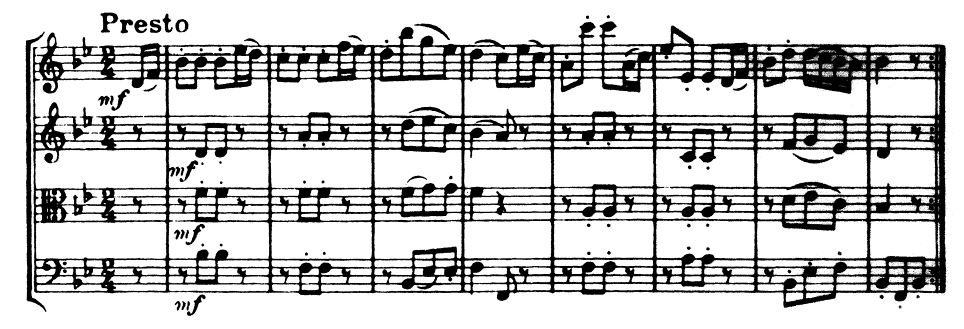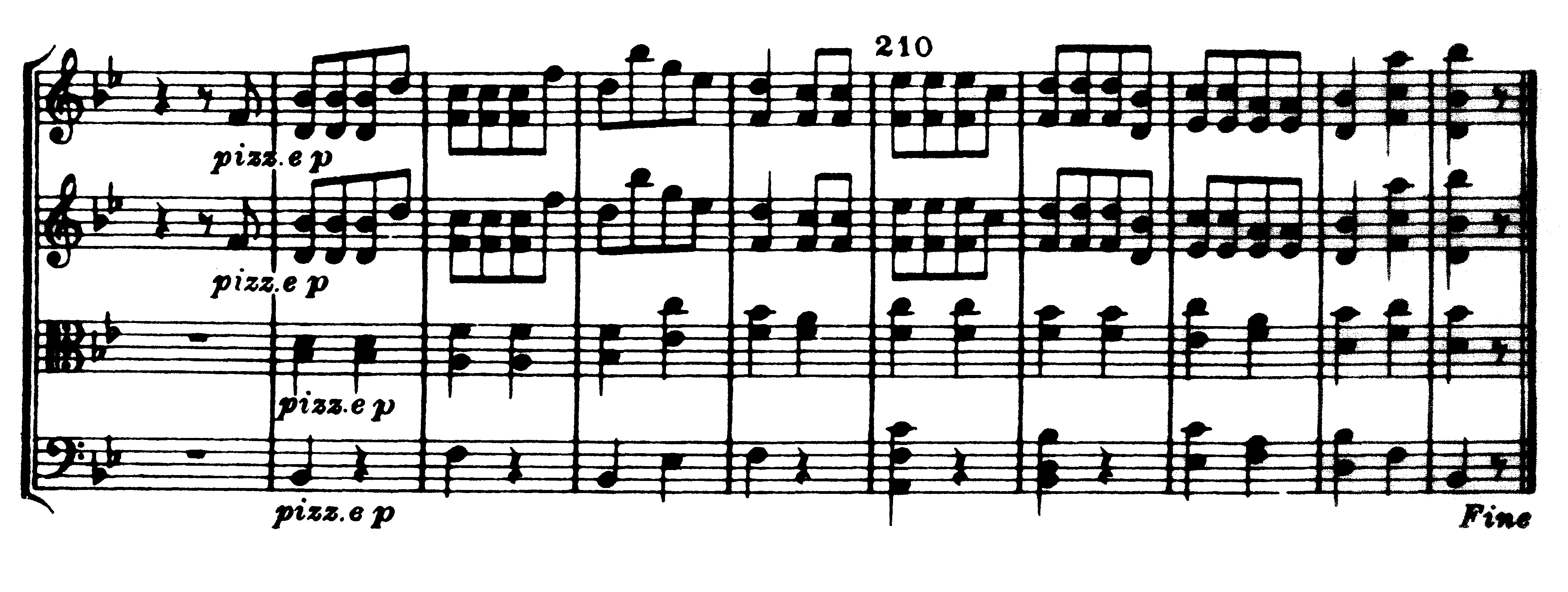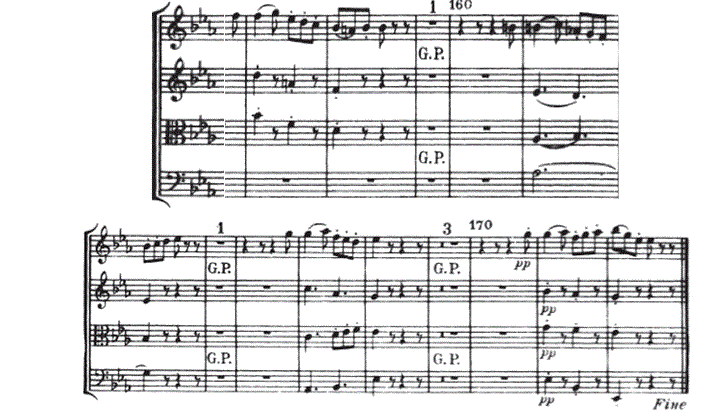Haydn’s use of rondo form in three of the six finales – those of no.’s 2, 3, and 4 – clearly demonstrates a new quality in Op. 33. Haydn began implementing rondo form regularly in the 1770s, appearing mostly in his symphonies and keyboard trios. Due to its clearly drawn contrasts, formal simplicity, and lightness of touch, rondo form is the antithesis of the fugal finales that characterize Op. 20. The differences between these two forms are telling: the rondo creates “opportunities for contrast as well as motivic development,”[1] whilst fugues allow for very little thematic evolution. Critics, including the Graves, have argued that Op. 20’s “monotony of unaltered reoccurrence” inspired Haydn to utilize rondo form in Op. 33 to avoid passages of “pure repetition.”[2]
Haydn exploited the rondo for its pleasant and facile connotations, whose “anticipated simplicity and regularity”[3] create expectation: the audience becomes accustomed to the pattern of reiterated episodes throughout a movement and therefore makes assumptions as to what will follow. Haydn’s aim regarding the three rondo finales was to exploit this phenomenon, sequence the finales in such a manner as to achieve that threshold of assumption in his audience, and, finally, to present them with the unexpected.
One of the most fascinating examples demonstrating Haydn’s manipulation of assumption is the structure of no. 2’s finale. This movement is structured in A – B – A – C – A’ form, the last section referring to the altered refrain. Haydn establishes the refrain’s normalcy by introducing it early and then re-implementing it amongst occurrences of the contrasting sections. The main A-theme is played six times in identical fashion, each time answering the building tension of a transitory B or C-section. With this, he demonstrates his true motives: the music frequents the return of the pleasant refrain enough so that the audience learns to crave it. He reiterates the original refrain (Figure 1.a) with an unexpected twist (Figure 1.b), to conclude the movement. This seventh recapitulation of the A-theme demonstrates the perfect example of thwarted expectation as discussed above. The expected theme then appears as chopped into fourths for the conclusion, each slice separated by long, awkward pauses. Finally, when the last slice of the theme is played, and one may assume the piece has ended, Haydn has the first two measures of the theme played once more. Expectation is set and challenged from the beginning of the final passage, when the theme we have become accustomed to hearing recurs, but broken into fragments.

Figure 1.a Op. 33, No. 2, fourth mvt, mm.1-8
Figure 1.b Op. 33, No. 2, fourth mvt, mm.157-172
The finale rondos certainly provide evidence that Haydn had a new compositional goal in the Op. 33’s quartets; he was clearly thinking in the larger scale of the movement as a whole. While an A-theme can be identical seven times, it nonetheless evolves according to its arrangement in the overall structure. This is especially apparent in the rondo finale of no. 3, sequenced in the following fashion: A – B – A’ – C. Haydn structured this rondo to create the same false expectations, but to alter the norm in a different way. After the A-theme and its B-answer are first introduced and repeated, measure 23 breaks the upbeat, major music with a dark, heavy passage. Afterwards, a long section of a call-and-answer variation on the main theme prolongs the return of the theme as a whole. The second A’ section contains slightly altered phrases from the first, but still generates an expectation of return. When an audience would learn to expect the piece to end with the refrain (mm. 1-9) – or at least some version of it – Haydn instead ended it with an entirely new contrasting section (mm. 150-170), and left it at that. This leaves the listener expecting more to follow, but not receiving it. When the A-theme returns in measure 72, it has no resemblance to the movement’s opening. The theme is no longer comfortable and upbeat, but instead provides a more pleasing answer to an unstable section.
In the finale of no. 4 Haydn returns to using the same tactic he did in no. 2. He structures it A – B – A’ – C – A’’, constantly reiterating the opening refrain. Haydn toys with the audience, going through the expected-to-unexpected cycle twice by creating anticipation for the normal refrain (Figure 2.a), and then throwing off the listener with a variation of the theme in the refrain (Figure 2.b), and once again, an even further twist in the concluding refrain (mm.190-214). The concluding refrain pauses at moments that, again, feel awkward to the listener, until it has been played through, when Haydn decides to conclude with a pleasant pizzicato (Figure 2.c) compiled from a sort of skeletal version of the original refrain, delivering a cute sense of relief. These playful implementations are characteristic to all three finales, and certainly provide evidence that Haydn was composing these movements with a grander scheme in mind. The rondo finales were not meant to merely carry a listener to the end, but to create a surprising and sometimes mischievous twist of the norm.
 Figure 2.a, Op. 33, No. 4, fourth mvt, mm.1-8
Figure 2.a, Op. 33, No. 4, fourth mvt, mm.1-8
_____________________________________________________________________________
Figure 2.b Op. 33, No. 4, fourth mvt, mm.154-161
________________________________________________________________________
 Figure 2.c Op. 33, No. 4, fourth mvt, mm.205-214
Figure 2.c Op. 33, No. 4, fourth mvt, mm.205-214
Haydn’s turn to rondo form suggests a “clear sign that Haydn has embarked on another course with Op. 33” that spurned “fugue and its associations – learned, transcendent, resistant to whims of fashion – in favor of an equivalent emphasis on the rondo, designed for popular appeal and positioned to end the cycle in a spirit of carefree exuberance.”[4] Sutcliffe agrees that, with Op. 33’s rondos, Haydn had improved his “ability to organize and provide coherence to long stretches of music and . . . vary the pacing of musical events . . . [and thus has a] more fluent rhythmic sense” than he had achieved with Op. 20. Sutcliffe furthermore observed Haydn’s tendency to emphasize the role of small phrases and their relationships with one another to form a larger picture. [5] This element of the Op. 33 quartets starkly contrasts with Op. 20’s, especially in regards to the extinction of fugal movements.
[1] Floyd Grave and Margaret Grave, The String Quartets of Joseph Haydn (Oxford: Oxford University Press, 2006), 121.
[2] Ibid., 12.
[3] David Wyn Jones (ed.), Oxford Composer Companions: Haydn (Oxford: Oxford University Press, 2002), 347.
[4] Grave and Grave, String Quartets, 204.
[5] Sutcliffe, Op. 50, 19.


